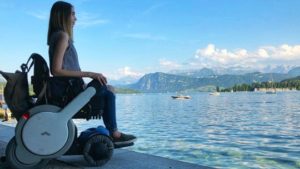by Rich Holmes, Sandwich, Massachusetts
With growing numbers of people getting vaccinated against COVID-19, many are looking forward to being able to travel again. But traveling with a disability imposes challenges too. On the FSHD Society Wellness Hour of April 12, 2021, guest speakers Ray Jordan and Carden Wyckoff shared travel tips and considerations. Both have traveled throughout the United States and Europe, and Ray also visits his native Australia. Here’s a summary of the discussion.
Protect your chair from damage

“Traveling in a wheelchair is a journey in itself,” Carden says. “There’s no guarantee your wheelchair will not get damaged on the flight. To be honest with you, I have about a 50 percent damage rate every time I go on a flight.”
Carden strongly recommends arriving an hour before your departure time, going to your gate and asking for the ramp supervisor or lead supervisor for the baggage loading crew. Explain the basics of how your wheelchair moves, and the location of the tie-down attachments. She suggests making a laminated copy of basic instructions with arrows showing the secure attachment points and showing it to the supervisor. She also urges you remove any parts of your chair that come off, such as the headrest, back seat cushion and footrests, and stow them in a carry-on bag. Remember to cover the control panel or joystick and other fragile parts with bubble wrap or protective cushioning.
Once at your destination, immediately check your chair, and if you find damage, file a claim with the airline. Your claim will be bolstered with evidence if you take pictures of your chair before you board and after you arrive.
Ray says that if you need damage repaired at your destination, you may get service on the same day if you report it that morning, but odds are you may have to wait a day. Inside tip: Ray suggests never booking an arrival on a Friday afternoon, because if your chair then needs repair, you’re unlikely to get service till the following Monday. Power chairs, scooters and rollators can be rented from Scootaround.com, which airlines use for wheelchair repairs and temporary replacements.
Damage occurs most often on domestic flights, as power chairs are stowed with luggage in a cargo bay, Ray says. He says he’s never had his chair damaged on international flights, as each wheelchair is packed into its own container.
Planning for a flight
Book ahead to get an accessible seat and to notify the airline of your needs. Repeat your needs to gate personnel at the airport to ensure you get help. Be aware that American Airlines no longer accepts power chairs weighing over 250 pounds, Carden says.
Bulkhead seats have more legroom for ambulatory people with FSHD, but Ray advises people using wheelchairs to avoid them. The reason? On most planes, the armrest on bulkhead seats doesn’t lift up, making a lateral transfer impossible. Southwest Airlines is an exception, he says.
Flights within the U.S. or Europe typically use single-aisle jets with a closet-size bathroom and may lack an aisle chair – a narrow wheelchair – for disabled customers. You can request an aisle chair prior to boarding. However, it may not be physically possible for wheelchair users to go to the bathroom on these flights. Carden says she dehydrates herself prior to flying, and suggests men consider using a catheter with a bag for urine. Other suggestions made by discussion guests include wearing incontinence products and placing a plastic garbage bag on the plane seat to ease transferring.
On international flights, larger double-aisle jets typically have a bigger bathroom, Ray says. A fight attendant will wheel you to and from the bathroom, where you’re left to perform whatever acrobatics necessary to get the job done.
“None of it is easy,” he says, “but it’s possible.”
Cruise ships
When planning a cruise, go online and check out the floor plans of ships that will be in the area you wish to visit. Pick rooms with adequate space around the bed and in the bathroom for a wheelchair to negotiate. Many ships offer accessible facilities, including hot tubs and pools with lifts, Ray says.
Be aware that at some ports, ships may anchor offshore, and use smaller motorboats to ferry passengers to land and back. These aren’t accessible to wheelchair users, Ray says. Most ships, if they offer accessible rooms, also offer wheelchair ramps when tied up in port. Similarly, onshore excursions sold to cruise passengers may not totally accessible. Check if the ground transport and featured sights are accessible before putting your money down.
Getting around in Europe
Unlike in the U.S., most airports on the continent don’t use jet bridges or jetways to connect planes to terminals, Carden says.
“They will provide services to get you onto the plane,” she says. The mechanical solution may be a wheelchair deck attached to a forklift-like apparatus.
European cities can be challenging, with cobblestone streets and plazas, and historic buildings far predating modern attempts at accessibility. Balancing these realities are a common respect for people with disabilities, generally good public toilet accommodations and extensive bike paths that provide a smooth alternative to bumpy cobblestones when tooling about, Carden says.
Trains form a major means of transportation but getting on and off means crossing the chasm between the station platform and the train car, which may also be several inches apart in height. In London, Carden says, you’ll hear cries of “Mind the gap!” While it may be possible in some cases to roll across the gap, wheelchair users will likely require a ramp. Arrive early, and ask a train attendant.
“Train attendants are very helpful,” Carden says. “Lean on them.”
Not all trains have fully accessible bathroom, she notes.
“Buses are the safest and most accessible form of transportation,” Carden says. “Buses are really awesome. Bus drivers know how to tie your restraints down. And people are really nice of moving out of these seats (in designated wheelchair areas) when they see a wheelchair come on.”
European hotels often feature accessible bathrooms with emergency cords and pull-down grab bars on one or both sides of toilets. Conditions vary by country, so do your research prior when planning your trip. Carden highlighted Germany for its accessible bathrooms, England for its curb cuts and Spain for its hospitality. Carden says she favors American chain hotels when traveling overseas, as she’s found they offer the best amenities.
When visiting cities, the areas most popular with tourists and those with newer shops tend to be more accessible, Carden says. Stairs may be the only way into older buildings and small family-run businesses.
“Restaurants, bars, doing other things out – that’s hit or miss” as to whether they’ll be accessible, she says. One chain drugstore put a temporary ramp down for her to enter, she says, and she relied on several fellow customers to carry her into a bar.
But being spotted in a wheelchair can have its benefits. Ray says he and his wife, Cyndi Segroves, another power chair user, stopped outside the Tower of London, where a long line of people stood. Ray asked a man who approached them about the line and was told the crowd was waiting to get in to see the British crown jewels. “Follow me,” the man said, and took Ray and his group past the line to a rear entrance. Soon they were eyeing the spectacular crown jewels, without having to wait.



Thanks Ray and Carden for sharing great tips and experiences for traveling, still a strong enjoyment for me. Always great to see you at the Wellness Hour too.
Great article Rich 🙂
Thanks for the insight